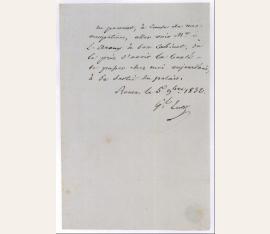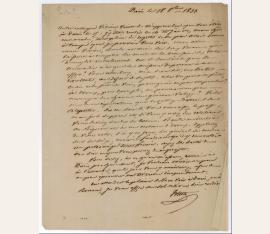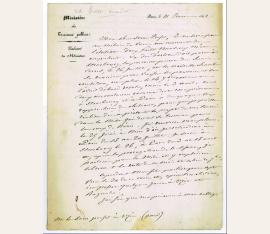avocat, député, ministre (1780-1852). Lettre autographe signée. Rouen. 05.11.1832. ½p In-8 (7 lignes).
$ 161 / 150 €
(45312/BN31683)
Il écrit à l'avocat Aroux de Rouen car il ne peut se rendre au cabinet de celui-ci et le prie de passer chez lui. - Ancienne collection de Foville.
avocat, député, ministre (1780-1852). Lettre autographe signée. Paris. 18.10.1833. 1p In-4 (28 lignes).
$ 193 / 180 €
(45315/BN31686)
Teste, devenu député en 1831, écrit à l'avocat rouennais Aroux, député aussi depuis 1831. Il a eu "tout plein de regrets de ne pas avoir su à temps qu['il] pouvait le voir", car Teste est rentré à Paris le 14 et Aroux est parti de Paris le 15, a-t-il appris par Alexandre-François Vivien (dit Vivien de Goubert, député). Mention aussi de Jean-Jacques Baude (député). Il parle d'une affaire en Normandie, à Evreux, pour laquelle Baude à écrit. - Ancienne collection de Foville.
avocat, député, ministre (1780-1852). Lettre autographe signée. Paris. 11.01.1842. 1¼ p In- 4 (31 lignes). Lettre à en-tête du ministère des travaux publics.
$ 214 / 200 €
(45316/BN31687)
Teste écrit à un sous-préfet du Gard. Il ne pourra être là pour les élections car le duc d'Orléans posera la premier pierre du chemin d'[?] à Strasbourg le 26 juillet, et ne pourra pas non plus être là le 14 septembre. Il explique son programme de l'été à son correspondant. - Ancienne collection de Foville.


